
Adjustment plastic windows- a procedure that may be required for any window. Knowing how to do it yourself is a useful skill that can save you money. The sash may stop functioning correctly and allow air to pass through as a result of prolonged use. The setup will help avoid large-scale repairs and restore functionality to the window.
Adjustment window fittings on plastic windows may be required if a low-quality installation was carried out: the craftsmen were in a hurry, did not adjust the sash correctly, and did not align the structure in two directions - vertical and horizontal. Natural wear and tear of the structure can make itself felt. The window begins to cling to the fittings when opening. The sash does not always close tightly, because of this gusts of wind penetrate into the room and blow from the window.
, every owner should know. This is a simple procedure that is easy to learn. There is no need to hire a specialist or purchase special tools for adjustment. By acting carefully, you will extend the life of the window for many seasons.You can get started by preparing the following tools in advance. You will need a 6-sided key for adjusting plastic windows No. 4, a screwdriver. Pay attention to what fittings you have installed: most often you can find Rehau windows. This profile is very popular and is installed in every third home.
Fittings may differ in quality and type; you can often find kits from Siegenia Aubi, Winkhaus, MAKO. may vary slightly depending on the type of fittings installed. The difference will be whether you need to remove the sash or not. Most often, it is enough to tighten the mounting screws.

If the frame is beveled, you will need to adjust the sash horizontally. This problem may appear due to shrinkage of the building, loose fittings, or improper opening of the window. To carry out the operation you will need to find window hinge adjustment window. The hole is designed for a hexagon, insert it there.
The adjustment must be made with the window sash open.
When turning the tool clockwise, the sash will gradually move away from the hinge. The lower part of the product, located opposite, will lower.
How to adjust plastic windows from the outside yourself? If adjustment of the lower part of the window is required, and you have the opportunity to approach it from the street, the window does not need to be opened. To adjust in this case, it can only move 2 mm.
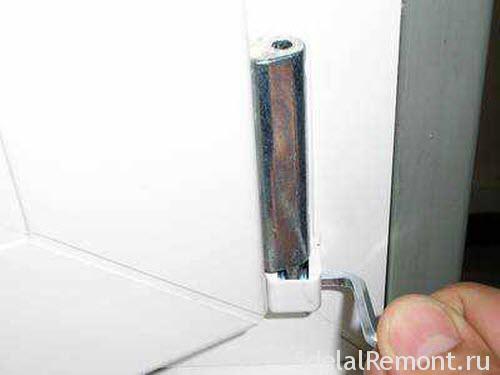
The procedure is carried out using a hinged loop located on the underside of the entire window. The hinge cap is removed and the adjustment mechanism is rotated. When moving the tool in a clockwise direction, the sash will be raised higher. By moving the key in the opposite direction, the element can be lowered. The error in this procedure is no more than 2 mm. If the window sash is longer than 1 meter, you will have to prepare for the fact that it will require frequent adjustments. The sagging in this case occurs due to the mass of the structure. The more often you open the window, the faster it will sag.
 Adjusting the plastic window vertically
Adjusting the plastic window vertically PVC adjustment windows may be required if the window does not close tightly. You can find out this way: close the window and place a lighted candle at the junction of the sash and frame. If the fire sways, then air comes from the gap.
If you have installed Roto fittings, you can adjust the structure using eccentrics: you can find them along the entire perimeter of the window. They work as follows: you turn the handle, the eccentric hides behind the pressure pad. If the closure is not tight, the eccentric must be moved clockwise, which will force the sash to press more tightly to the frame. Turning counterclockwise will move the sash back.
Adjustment of the plastic window should be smooth. Move the mechanism no more than 2 mm at a time. Watch the position of the eccentrics: it should be the same everywhere. There are special risks to determine the tightness of the sash. They should look at the seal. If the risk is facing in the opposite direction, the sash should be tightened.

Other profile models require the presence of eccentrics in the hands to turn wrench or pliers. Some types of fittings are adjusted using plates. Inspect the hinge mechanism: there should be a clamping device with a tongue. If the tongue is not extended, the sash is not pressed well.
Window adjustment with hinges on the left side. Here the system is slightly different: the key must be moved counterclockwise so that the sash is pressed. If the hinges are right-handed, move the key in the opposite direction.
Self-adjustment of plastic windows and doors should be carried out at the beginning of each season. For example, in winter it makes sense to press the sashes against the frame, and in summer, on the contrary, to loosen them. Since in the heat the window material expands. This will help extend the life of the seals. Adjustment up to 0.8 mm is allowed. If this does not help, you will no longer be able to do without the help of a specialist.
 Adjusting the pressure of a PVC window
Adjusting the pressure of a PVC window Notice how the handle works. It should turn without effort. If force is required, all elements must be lubricated rotary mechanism. This can be done with regular machine oil; you will need to apply it using a cotton swab or an oil can. You can use silicone lubricant or WD 40 spray and spray it in the right places.
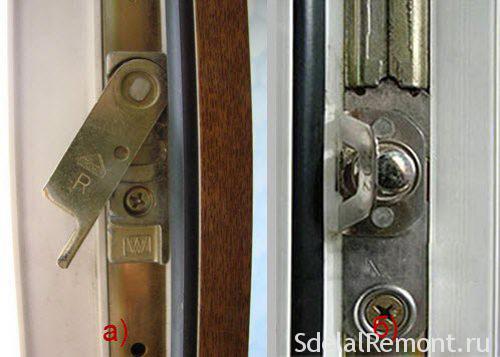 Locking in "closed" mode
Locking in "closed" mode This procedure is required if it is blowing from the window. Everything is done simply: the unusable seal is pulled out of the grooves, and a new one is inserted in its place. There is no need to stretch it. If you hear squeaking, use silicone lubricant. Frequent replacement of this element is not required: usually it is needed no more than once every ten years.
At the right approach adjustment metal-plastic windows will not cause any difficulties even if you have no experience in such matters.
Plastic systems are the undisputed leader in modern market window designs. They are relatively inexpensive, practical, environmentally friendly, convenient for everyday care, and provide good heat and sound insulation. All of these benefits can be enjoyed if the windows were manufactured by a reputable manufacturer and installed by a qualified professional. Otherwise, we are faced with the question: how to adjust plastic windows? Poor installation or low-quality fittings can lead to window sashes becoming warped, jamming, and not fitting tightly together. The result may be a draft, the infiltration of street moisture, and in especially severe cases, even the ingress of precipitation - rain and snow.
What to do in this case? The best option– call the company representative who installed the structure. If this is not possible, for example, the company has ceased to exist or the warranty period has expired, you can invite a specialist from another company.
However, in this case, you have no guarantee that the adjustment will be carried out efficiently and that after the repair, problems with double-glazed windows will no longer arise. Therefore, another option is to read the instructions or watch a video on the topic “How to adjust plastic windows” and make the adjustment yourself. With a certain skill and appropriate theoretical training, you can adjust plastic windows and doors yourself.

Basic tools for adjusting windows: wrenches and screwdrivers
In order to independently adjust window fittings on plastic windows, you need to have on hand:
Advice! Lay out all the tools so that they are at hand, but not in the way during adjustments.

All problems that may arise with double-glazed windows can be divided into several main groups. How to adjust plastic windows, what tools to use, and whether you can rely on own strength Or it’s better to contact a specialist.
The most common types of faults are:
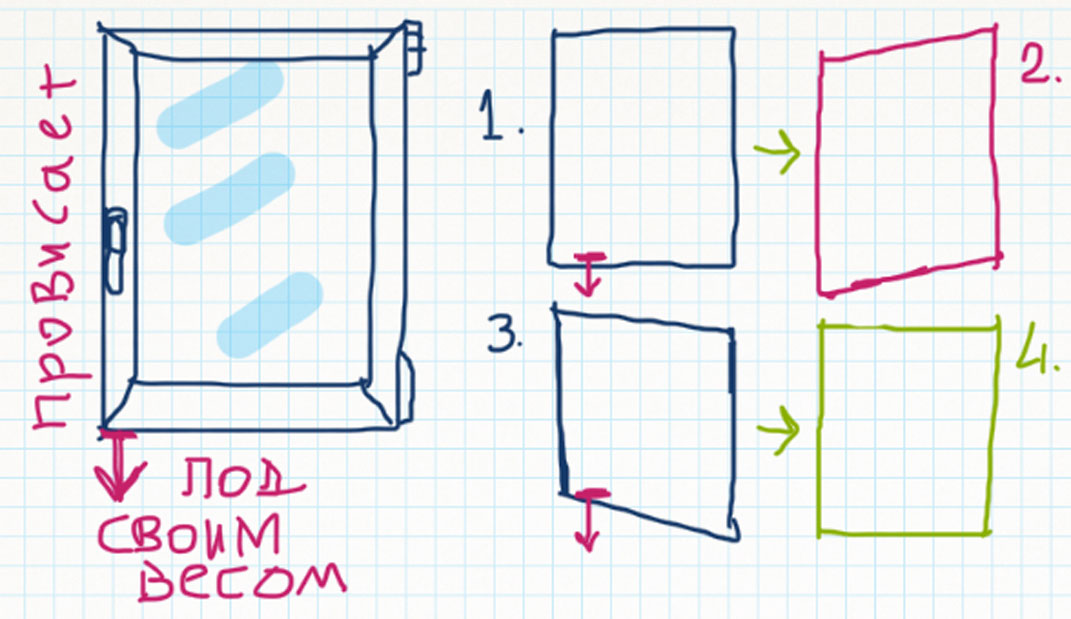
Sagging of plastic window sashes is the most common defect during installation.

Advice! All these defects can be eliminated by self-adjustment, without resorting to the services of outside specialists.
Problems with window fittings most often arise as a result of the use of low-quality components or as a result of careless operation. We suggest considering ways in which you can adjust plastic windows yourself.
Before you start adjusting plastic windows yourself, carefully read the instructions and remember a few nuances that will help you in your work:
![]()
As a rule, failures of plastic windows are caused by improper use window fittings and untimely adjustment. Small parts can create a lot of problems if not taken care of. Let's look at the basic rules that will help you prevent damage to plastic windows and fittings:
These simple rules will help extend service life window systems and prevent breakdown. Unfortunately, most owners of plastic windows are negligent in adjusting and caring for them. This is the cause of many malfunctions. It is necessary to maintain cleanliness and monitor the blocks from the day of installation. Proper care and adjusting plastic windows will not only ensure efficient performance of functions, but will also save money family budget by preventing breakdowns.
No matter how expensive and high-quality the fittings of your plastic windows are, after some time they will inevitably become loose and require adjustment. To eliminate any malfunctions that appear, you can contact a specialized company. However, this option has many disadvantages. Not only will you have to wait for the master to come to your call, but you will also pay quite a lot of money for the most basic work.
In fact, you can adjust PVC windows yourself. You just need to understand which part of the system is loose and perform a few simple steps in accordance with the instructions.


You can understand that the time has come to start adjusting PVC windows by the following signs:
These and other problems characteristic of PVC windows can be easily eliminated with your own hands if you have basic tools to use.


The most common case is when the window sashes begin to fall and rub against the frame during the process of opening and closing the window. If you leave things to chance, eventually the window will simply break completely, and the only option to fix the problem will be to completely replace it.


It takes an average of 30-40 minutes to eliminate such friction. And you practically won’t need any money for such repairs. In any case, the costs will be an order of magnitude lower than in the case complete replacement window design.
First step. Open the window and find the special adjustment screw at the end of the window sash. In most situations, this screw is placed near the top of the window sash.
Second step. Turn the found screw a little using a hexagon. If you need to lift the sash, rotate it clockwise. If it is necessary to lower the mechanism, the screw must be turned against the direction of the arrow.
Third step. Try closing and opening the window. If after your actions the window sash begins to cling less to the structure, tighten the screw in a certain direction until you achieve the desired result.
If there is no change, return the screw to its original position and use the following method.
First step. Carefully remove the protection from the bottom window hinge.
Second step. Start turning the adjusting screw little by little, literally half a turn. Select the direction of rotation as in the previously discussed method.
Third step. Check how the plastic window works after your manipulations.
This simple balancing of the lower canopy or upper mechanism will allow you to return the sash to its place and get rid of friction. You just need to establish exactly in which direction the adjusting screw needs to be tightened to achieve the desired result.


Over time, the elastic band that acts as a seal loses its original volume, which is why cracks of various sizes begin to appear in the frame. Even more often, such cracks appear during seasonal temperature changes.
To check the quality of frame clamping, just take a piece of any paper and press it with the sash. If you can pull out the sheet without much effort, the pressure has deteriorated and the windows need adjustment. If you were unable to pull out the paper or took it out with great effort, everything is fine with the window and there is no need to adjust anything.


To correct the problem in question, it is not at all necessary to change the seal. In most cases, it is enough to simply tighten up certain mechanisms.
Residents of regions with significant temperature changes in winter and winter need to understand the features of such adjustment. summer time. Timely adjustment will reduce the intensity of the internal stress of the system and extend the service life of the seal, fittings and the entire window as a whole.
Open the plastic window and carefully examine the sash. There are eccentrics on the end part of this element in special slots in the plugs. They look like cylinders. When the position of the handle changes, these eccentrics fit into grooves specially arranged on the frame of the plastic window.
If there are no deviations, the cylinders fit normally into the grooves and the sash is pressed tightly against the window frame. If the balancing is disturbed, the fit of the sash becomes less tight, and drafts appear. To correct the defect, it is enough to adjust the position of the hooks.
Turn the eccentric 90 degrees. In most cases this can be done manually. Sometimes you have to use pliers or a screwdriver. Eccentrics usually rotate along a small radius, and not directly around their own axis. Typically, such manipulations eliminate the problem in question.
Be careful when checking the correctness of such window adjustment; you should not immediately try to close it in a big way and press the sash tightly against the frame, as this can damage the fittings.
If you cannot turn the eccentrics, tighten the counter hooks located on the window frame. This is done using a hex key. If you find that the eccentrics simply do not reach the counter hooks, place a thin plate of metal or other material under the hooks. suitable material, for example, plastic.
The manipulations described above will allow you to normalize the frame pressure in the handle area. However, to achieve maximum effect, it is necessary to adjust the intensity of the pressure on the side where the canopies are placed.
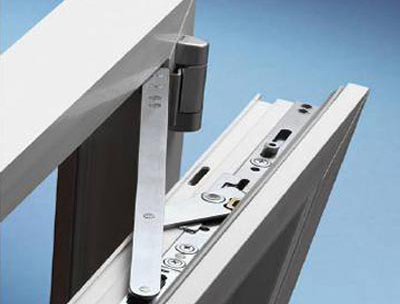

Adjustment from the installation side of the awnings can be performed in different ways. So, if installed PVC the window moves exclusively along its vertical axis; for repairs it will be enough to slightly tighten the already familiar adjusting screw. You will find it on the bottom window hinge. If the structure can be opened for winter ventilation, the adjustment procedure will become somewhat more complicated.
Remove the plug from the lower canopy. You will see 2 hex bolts, as well as one hidden fastener. These elements will allow you to adjust the position of the awnings.
The clamping force is set using a bolt screwed in at an angle of 90 degrees to the window. Turn the screw in the direction of the clock hand and the window sash will press harder. Turning the screw against the direction of the arrow will weaken the pressure. The manipulations in question are best performed with the window closed.
At the top, the sash is fixed differently. A mechanism known among installers as “scissors” is used here. To get to the mentioned mechanism, open the window and carefully examine the surface of the sash end. On it you will find a locking mechanism. It is quite easy to recognize - the mechanism is attached to the gasket and springs noticeably.
Press the lock and turn the window handle as if you were opening the window for ventilation. After such manipulations, the window sash will remain hanging only on the lower canopy and those very “scissors” located on top. Now you have access to the head, with which you can adjust the clamping force window frame. First determine in which direction you need to adjust the mechanism, and then make the final adjustment.


The handles also need periodic attention and adjustment. If the handles of your windows are loose, the entire repair will consist of simply strengthening their fastenings. You just need to arm yourself with a screwdriver and tighten the screws.
Pull back decorative overlay, installed at the bottom of the handle towards you, and then turn the handle perpendicular to its original position.
Tighten the bolts (most often there are 2) with an ordinary screwdriver.
Check the handle and, if necessary, tighten it more or loosen the fastenings.
If you are unable to remove the cover manually, use additional accessories, such as a knife. But be careful - such products are made of soft plastic and are easily damaged by sharp tools.


Quite often the handle begins to jam or does not reach the required position. Various reasons lead to this problem. First, try simply lubricating the fittings.
Pull out the handle. Clean the mounting hole thoroughly. You can even vacuum it.
Lubricate moving parts. Any liquid lubricant will do; sewing machine oil is usually used.
Treat corroded surfaces with a special WD-40 spray. If there is no corrosion, you can skip this step.
Return the handle to its place.
If your window handle is stuck and you cannot return it to its normal position, do not try to solve the problem by force. This way you risk simply breaking the mechanism. In most cases, the cause of this problem is the erroneous operation of the locking mechanism.
To solve the problem, just pull back the lock lever. Find it at the end of the window sash. The lock is located near the handle and without extra effort retracted manually.


In order to avoid future problems with disruption of the normal adjustment of windows and related fittings, it is strongly recommended to carry out basic service operations in a timely manner. Conduct an audit at least once a year. Preventive maintenance comes down to simply lubricating the main components of the system and moisturizing the seals.
It is also important to comply following rules operation of PVC windows:

Thus, minor repairs plastic windows can be easily done with your own hands. But you can begin performing any operations only after fully studying the basic principles of operation and recommendations for using the window. Otherwise, you risk only making the situation worse. Follow the recommendations received, be careful, and everything will work out.
Good luck!
Do-it-yourself adjustment of plastic windows may be required at any time, despite the guaranteed long service life of PVC structures. This simple operation can be easily performed by anyone. home craftsman, if you understand some of its subtleties.
Modern plastic windows are made using massive and truly reliable fittings. It guarantees trouble-free operation of structures for many years. But even highly reliable mechanisms require periodic maintenance and adjustment. It is possible to perform such operations with your own hands. It is enough to stock up on simple working tools and understand the key components of PVC structures.
Adjustment of PVC windows
Adjustment of the plastic window is made using a screwdriver (Phillips), designed for several various sizes, a set of hexagons, star and cross-shaped nozzles marked TX or T, machine oil and pliers. No other devices will be needed. In most cases, it is possible to adjust windows using a hexagon (popularly called a furniture wrench). Such a tool may have the shape of the letter S. But more often it is made in the form of an L-shaped metal rod that can easily handle.
Star-type nozzles are used infrequently. With their help, it is possible to restore the functionality of a plastic window with your own hands using rarely found types of fittings. In other cases, all problems that prevent the window from closing or opening can be solved using an ordinary Phillips screwdriver. There are several points for customizing window designs. They are the same for all PVC products, regardless of which company manufactured them. The adjustment points are located:
If the indicated points are deformed, it is prohibited to adjust the windows yourself. In such cases, you need to contact specialists. Sometimes, after long-term use of window structures, they become clogged with dust and small debris, which should be removed and then the planned work should be carried out.
It is advisable to carry out technical inspection of PVC structures regularly. Such an inspection of the condition of the windows will not be superfluous. But they need to be adjusted directly as needed. Note that even in cases where the initial configuration of the structures was carried out to the highest possible quality, certain problems may arise when using them. They are usually associated with violations of the tightness and integrity (structural) of windows, breakage of the fasteners used, and violations of the recommended operating rules for plastic products.

Strengthening the window handle
By independently adjusting PVC window structures, you can solve the following problems:
Another common problem is difficulty turning the window handle. This problem occurs either due to a lack of lubrication or due to improper lowering of the sash. You will either need to lubricate the problematic product with machine oil, or disassemble the handle and adjust the stroke of its roller. Next, we will tell you in more detail how to properly adjust plastic windows in order to solve all the problems described.
First, let's look at how to adjust a window product vertically. Everything here is elementary. Find the location of the hinged bottom hinge, open the plug under which it is hidden. Insert the hexagon into the special hole and begin to carefully rotate it clockwise. This will cause the sash to rise. If you rotate the tool in reverse side, the sash will lower. Windows are calibrated horizontally in the same way. This setup allows you to solve various problems with plastic structures.

Plastic window calibration
If you need to fix a slight bevel of a window or a shift in its frame, you will need to remove the cover from the bottom hinge and use a furniture key according to the scheme already described above. Horizontal calibration makes it possible to adjust the window both from the inside and from the outside. outside. In other words, you can easily adjust the window structure in a closed or open state. In practice, everything looks like this. Insert the hexagon and turn it.
When rotating counterclockwise, the lower section of the window structure will begin to lower. If you turn the adjusting key in the opposite direction, the bottom of the window will begin to rise.
Horizontal adjustments can also be made on the top hinge of the structure. This need arises if a plastic window does not close well. Here you need to know one nuance. Such calibration is carried out only when the window is open. The principle of setting remains unchanged. Let us add that the shift of the sashes with the described repair methods is carried out by no more than 2 mm.
The seal located around the perimeter of PVC products loses its original volume over time. This causes gaps to appear in the heat and. A similar situation can arise due to temperature changes outside. Some people immediately turn to specialists for help. They advise replacing the seal. As a result, restoring the window structure costs a pretty penny. But the problem can be solved more simply. It is enough to slightly change the clamping force to return the window to its heat and sound insulation characteristics.
At the end of the window sashes there are special oval cylinders. These protruding elements are called eccentrics (or trunnions). You will find them in the slots of the metal plugs. On the window frame there are hooks into which the above pins enter when you turn the window handle. You can change the pressing force of the sash in two ways - by moving the hooks and turning the trunnions. You need to turn the protruding section of the eccentric towards the outer surface of the PVC structure (if you need to reduce the amount of force) or towards inner surface(when you need to increase the effort).
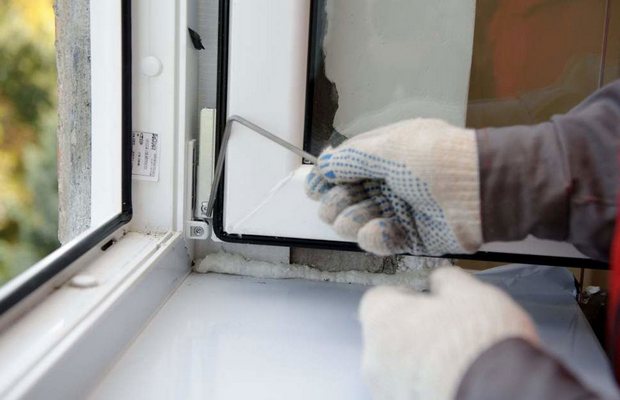
Do-it-yourself PVC window setup
Take into account! The calibration methods for fittings from different manufacturers differ from each other. There are three ways to adjust the clamping force:
In cases where it is impossible to adjust the trunnions, you can try to calibrate the hooks. They are usually secured with two bolts. You need to loosen these hardware with a hexagon and move the adjustable element (hook) towards the street (if you want to increase the pressure) or towards the room (to reduce the pressure).
Experts do not advise excessively clamping the window frame and its sash. The design in this case will not close and open better. But early wear of the seal is guaranteed. If you want your home to always have an ideal microclimate, readjust the sash pressure twice a year. Tighten them tighter before the onset of cold weather (then in winter the cold air will not penetrate into the room at all) and loosen them in the spring so that a small air flow enters the home.
Handles on plastic products are subject to the greatest load. We constantly open and close windows and do not always do it carefully. The result of such carelessness is the loosening of the handle. To correct similar situation very simple. Find the pad under the loose part rectangular shape, pry it up with your fingers (do not use metal tools, as they can damage the edge of the plug or even the profile itself) and turn it 90°. Bolts will open in front of you. Use a Phillips screwdriver to tighten them, then return the trim to its place.

Self-repair of PVC windows
It is more difficult to cope with a handle that does not reach any given position or noticeably jams. First, dismantle the closing mechanism, thoroughly clean its internal parts, and then treat them with oil (machine oil). If this does not solve the problem, try reducing the clamping force on the sash. You will need to adjust the hooks and trunnions. We discussed this technique in detail in the previous section of the article.
Sometimes the handle gets stuck. There is an opinion that such a malfunction definitely requires replacing the device that closes the window. This is wrong. Moreover, you don’t even have to dismantle the handle to wedge it. The problem in this case arises because the locking device on the PVC structure does not work correctly. The problem can be corrected simply - at the end of the sash, find the locking lever (it can be made in the form of a clip or in the form of a small tongue) and carefully move it away. This is all. The functionality of the pen has been restored!
And one last thing. Hinged PVC windows are equipped with two hinges. These elements can be calibrated independently using a screw. A similar operation is performed to improve the functionality of the loops. Turning the screw to different sides, you adjust the degree of their pressure, which means you can choose optimal mode ventilation of your home. The adjustment range for the hinges is within 2.5 mm. Now you know how to properly adjust a plastic window. Don’t waste your family budget by calling experts to repair PVC structures. After all, you can solve almost all problems with windows yourself.